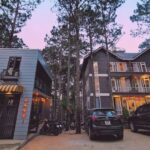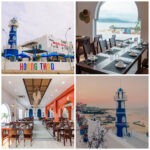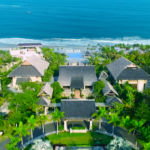Pizza 4P’s
Yosuke Masuko, a Japanese entrepreneur, opened Pizza 4P’s in May 2011 in the Vietnamese city of Ho Chi Minh City. Vietnam is a rice-loving country, but Mr. Masuko says the restaurant now serves around 350 diners every night, about two-thirds of them Vietnamese.
Credit…Aaron Joel Santos for The New York Times
Yosuke Masuko, a Japanese entrepreneur, opened Pizza 4P’s in May 2011 in the Vietnamese city of Ho Chi Minh City. Vietnam is a rice-loving country, but Mr. Masuko says the restaurant now serves around 350 diners every night, about two-thirds of them Vietnamese.
Đang xem: Pizza 4P’s
Credit…Aaron Joel Santos for The New York Times
Mr. Masuko, center, and his wife, Sanae, take a farm-to-table approach to pizza, a kind of holistic business model that is rare in Vietnam.
Credit…Aaron Joel Santos for The New York Times
A burrata and prosciutto pizza, left, and a “Four Flowers” pie, both on the pizzeria’s menu.
Credit…Aaron Joel Santos for The New York Times
The restaurant’s full name is Platform of Personal Pizza for Peace, which one employee says reflects an effort to listen to customers and to constantly improve their pizza experience.
Credit…Aaron Joel Santos for The New York Times
In 2012, Mr. Masuko opened a small facility in rural Vietnam to make cheeses for his pizzas, including mozzarella, shown here. He now sells several varieties of cheese to upscale hotels and restaurants across Vietnam and Southeast Asia.
Credit…Aaron Joel Santos for The New York Times
Burrata, a mix of mozzarella and heavy cream, being chilled in an ice bath. After an Italian customer requested fresh burrata as a topping in December 2012, Mr. Masuko decided to make it a mainstay of the menu, even though producing the cheese locally requires considerable effort.
Credit…Aaron Joel Santos for The New York Times
Mr. Masuko also has contracts with five farms to grow tomatoes, eggplant and other ingredients.
Credit…Aaron Joel Santos for The New York Times
The farmers include Motoyuki Takano, one of five Japanese who moved to Vietnam after the Fukushima nuclear plant accident and began working for Mr. Masuko. The former Tokyo businessman said he learned how to farm, in part, by reading about it online. ‘‘We are very, very beginner!’’ he said, laughing. ‘‘But no stress.’’
Credit…Aaron Joel Santos for The New York Times
DON DUONG, Vietnam — The cheesemaking hub of Universal Food Creation, a narrow orange building, looks no different from the other structures lining the main street in this dusty farming village in southern Vietnam.
But on a recent Wednesday morning, about a dozen workers made mozzarella and burrata cheeses in metal bowls with milk from 25 neighborhood cows. The fresh batches, produced with Danish rennet, would ship that evening to upscale hotels and restaurants across Vietnam and Southeast Asia.
Yosuke Masuko, the company’s chief executive and a former financial strategist from Tokyo, opened the modest factory in 2012 to complement his popular restaurant, Pizza 4P’s, in Ho Chi Minh City, about 200 miles south.
In addition to fresh cheeses, his toppings include vegetables grown on five farms not far from the factory. The farms, which have contracts with the company, are scattered across the southern portion of the country’s Central Highlands, a hilly region with a temperate climate.
Mr. Masuko’s holistic approach to pizza is reminiscent of farm-to-table enterprises in Europe and the United States, but is a rarity in Vietnam. The key to his success appears to lie in a technical precision honed during his previous career in finance, coupled with a quixotic instinct to engineer the perfect pizza experience.
The overall goal is “delivering wow and happiness,” Mr. Masuko, 35, said at the 860-square-foot factory as two Vietnamese employees weighed balls of burrata on a digital scale and sealed them in plastic bags. But to create those effects, he added, “The important thing is detail, detail, detail, detail, detail.”
Pizza 4P’s serves around 350 diners every night, about two-thirds of them Vietnamese, and on average turns away another 50, he said, even though the restaurant has doubled in size since it opened without any formal marketing in May 2011. It does not deliver, and seasoned customers typically reserve tables in advance.
This in a country that has a rice-based cuisine and an annual per capita income that is the equivalent of around $1,800.
While Mr. Masuko began making cheese to serve his pizza restaurant, he now also has a separate cheese export business that sells 10 varieties, including camembert and mimolette, to upscale hotels and restaurants in Vietnam, Cambodia, Singapore and Japan. It accounts for 15 percent of his total revenue.
Geoffrey Bouillet, operations manager for four restaurants in Vietnam owned by Didier Corlou, a French chef, says that Mr. Masuko’s camembert works nicely in a salad with arugula and artichoke. And at 55,000 dong, or $2.59, for a 5.3-ounce portion, it costs roughly half as much as the imported French version.
“It’s a nice product, not so strong as a Camembert from Normandy,” Mr. Bouillet wrote in an email. “But a very nice value.”
Mr. Masuko is a self-described “pizza maniac” who said he developed a love for the dish about 10 years ago after building a wood-fired pizza oven in his Tokyo backyard at the request of a now former girlfriend. He later traveled on pizza pilgrimages to Rome, Naples, London and other European cities.
In 2008 he moved to Hanoi, the Vietnamese capital, as the country director for CyberAgent Ventures, a Tokyo-based venture capital firm specializing in high-tech investments. But soon he began pondering ways of striking out as an entrepreneur. Given his interest in pizza and Vietnam’s rising middle class, he said, opening a pizzeria with a wood-fired oven struck him as a logical strategy.
Mr. Masuko said he leased an alley-side building in Ho Chi Minh City and invested about $100,000 of his savings into a renovation, kitchen gear and other start-up essentials. He and a Japanese employee, Keinosuke Konuki, taught themselves how to make mozzarella by watching a YouTube video.
Finding the highest-quality milk entailed traveling around Vietnam by motorbike and talking with small-scale farmers, who typically agreed on a price of around 15,000 dong per liter, or about 71 cents for a quarter of a gallon, Mr. Masuko said. He made the cheese in his apartment, and later at the restaurant.
Xem thêm: Top 9+ Địa Điểm Du Lịch Miền Nam Không Nên Bỏ Qua, Danh Sách Tour Du Lịch Miền Nam
Mr. Masuko and his wife, Sanae Masuko, who met in Japan while working together at the parent company of CyberAgent Ventures, said one obstacle to starting Pizza 4P’s was her parents, who were highly skeptical of the whole idea. “I was a very good child, and I always followed their decisions,” Ms. Masuko, 30, said. But she disobeyed them in this particular case.
Pizza 4P’s is now rated in the top three of the roughly 5,000 restaurants reviewed on the Vietnamese food website Foody.vn, which draws about 1 million unique visitors per month, according to Dang Minh, chief executive of the site’s parent company, Foody Corp.
Customers like Pizza 4P’s, where the average pie costs about 200,000 dong, because it serves quality products at competitive prices, Mr. Minh said. He added that the restaurant’s Japanese-influenced pizza toppings, such as fish sashimi and teriyaki chicken, appeal to local palates.
“The taste is delicious and the price is reasonable,” Vuong Binh, an import-export dealer from Ho Chi Minh City, said on a recent Monday evening in the restaurant’s packed dining room.
Francesco Patella, a Vietnam Airlines pilot from Italy, was sitting on the mezzanine with a group of other Italian pilots. He said Pizza 4P’s could easily rival pizzerias in both Naples and Rome, and he had even come to love some of Mr. Masuko’s nontraditional creations, such as a four-cheese pizza served with honey for drizzling.
His only major complaint was that the pizzas were always cooked and served one at a time, forcing him to share rather than eat his own.
The pilots said the restaurant’s specialty — a pizza topped with prosciutto, arugula and a ball of fresh burrata — was unheard-of in Italy because fresh burrata, a mix of mozzarella cheese and heavy cream, is so expensive. (Mr. Masuko said after an Italian customer requested fresh burrata as a topping in December 2012, he decided to make it a menu mainstay even though producing the cheese locally requires considerable effort.)
It quickly became the pilots’ favorite, and they now order it whenever they eat at Pizza 4P’s, usually once or twice a week.
“This kind of pizza in Italy would be impossible” because a ball of burrata costs around 9 euros there, or $12, said Mr. Patella, who was the head pizza chef for about 10 years at Spaccanapoli, his family’s restaurant in Rome. “He has a brilliant idea.”
The pilots and other customers said they were impressed by the attention to detail. Toppings, for example, are positioned according to how many people plan to eat the pie, so cutting is easier and toppings won’t slide off, Mr. Masuko said.
Pizzas also are baked for a specific period of time, which he asked a reporter to keep secret because he considers it proprietary information.
Mr. Patella said Mr. Masuko occasionally refused to be paid for pizzas that were not perfectly round, even though Mr. Patella could find nothing wrong with them. (Mr. Masuko noted such times were extremely rare, in part because of his rigorous quality control standards.)
The restaurant’s full name — Platform of Personal Pizza for Peace — reflects such a continuing effort to listen to customers and constantly improve their pizza experience, said Takayuka Oka, one of Mr. Masuko’s employees.
Mr. Oka is one of several Japanese employees. Another is Masashi Kubota, the cheese department manager in Don Duong, who trained in France and emailed Mr. Masuko from Hokkaido to ask for a job after searching online for “Asia” and “cheesemaker” in Japanese.
One of the five contract farms is staffed by five Japanese farmers who moved to Vietnam after the Fukushima nuclear plant accident, said one of them, Motoyuki Takano.
At 7:30 a.m. on a recent Thursday, Mr. Takano was inspecting rows of tomatoes and eggplants inside a 1,000-square-meter, or 10,076-square-foot, greenhouse in Dasar, a village about 50 miles from the cheese factory in Don Duong.
Mr. Takano, 32, a former Tokyo businessman, said he had learned how to farm partly by reading about it online, and that the real thing is full of surprises. For example, Mr. Masuko had asked him to grow San Marzano tomatoes, an Italian variety, for the restaurant’s pizza sauce but the project failed for reasons that are still not entirely clear.
As a result, the restaurant has continued to import San Marzanos while Mr. Takano grows salad tomatoes from Japanese seeds.
“We are very, very beginner!” he said amid peals of laughter. “But no stress.”
There have been other obstacles, Mr. Masuko said, including a failed attempt to build a cheese cave at the factory and difficulties in importing rennet from Denmark, which he says he prefers because it offers the best combination of quality and value. He also said some of his former employees had moved to another pizzeria in Ho Chi Minh City and appropriated some of his signature dishes.
But Mr. Masuko recently purchased a one-hectare, or 2.5-acre, farm near Don Duong where he intends to grow vegetables and try again to build a cheese cave. He also plans to buy 10 cows, possibly from Thailand because, he said, its dairy cows tend to be of higher quality than Vietnamese ones.
He is determined to expand his brand far beyond Ho Chi Minh City, with an initial goal of opening Pizza 4P’s restaurants in every Southeast Asian capital, and later in Tokyo, London and New York.
He also intends to develop a fast-food-style version of the restaurant, starting in Ho Chi Minh City, Bangkok and Singapore, although he has not leased any sites yet.
Xem thêm: Top 5 Homestay Hải Phòng (Cập Nhật 03/2021), Homestay Tại Hải Phòng
As for longer-term goals, he has been browsing auction websites in hopes of finding an island for sale at around $10 million. By 2025, he wants to open an ecological resort on a private island — in Asia or beyond — where guests could learn about pizza making and sustainable agriculture.






Bình luận